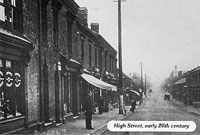Brownhills in history

Although the history of Brownhills goes back only two hundred years, the area on which the town stands has a history dating back to prehistoric times.
Long before the Romans built Watling Street important ancient trackways crossed here.
There are records of remains of an ancient burial mound at Catshill and of a reputed Roman watch post at Knaves Castle which have long since been destroyed.
The name first appeared on maps and documents in the early 18th century. The area along Pelsall Road, then Wolverhampton Lane, was settled by coal miners. The lands belonged to the Hussey family, Lords of the Manor of Norton Canes. The Wyrley and Essington Canal was opened in 1797. Norton Pool, now Chasewater, was built in 1799 as a reservoir for the canal system. The heath lands of Ogley Hay were enclosed in 1838, providing farming land for the growing population. Early in the 19th century Coppice Side was settled and pits spread north towards The Rising Sun inn. A horse-drawn tramway was built linking the workings with the canal loading wharves.
Ogley Hay, being originally extra-parochial, that is outside any parish, was declared a parish in 1838 but there was no parish church until 1851 when St. James's Church was built. With the coming of the South Staffordshire Railway in 1850 the High Street, then called the Old Chester Turnpike Road, with a toll gate at Anchor Bridge, became an important trading area. With the railway came two men who shaped the future of the town. John Robinson McClean, railway engineer, opened up the pits around Chasewater, built the Anglesey Branch Canal and railway line and founded the South Staffordshire Water Works. William Roberts, a pit boy and ganger on the railway, became a local magistrate, Chairman of the Council, owner of public houses, farms and numerous properties in the area. He was also a great benefactor to the town until his death in 1906.

In 1858 a railway line was cut through the middle of the early mining settlement and the community moved east towards High Street and Ogley Hay. Mining 'ghettos' were formed around St. James's Place and Ogley Square, now the site of the Wheatsheaf in Ogley Road. A coffee house on the corner of High Street and Lichfield Road opened in 1854. Its Library and Reading Room soirees and theatre evenings became the cultural centre of Brownhills. In 1913 it became the first Working Men's Club in Brownhills. It has now been demolished.
In 1877 Brownhills Local Board of Health was formed, giving control of the town to a locally elected council. The first Board meetings were held at 14 Pelsall Road. In 1882 the Board Offices were built and the distinctive clock added in 1911. In 1894 Brownhills Urban District Council was formed, lasting until amalgamation with Aldridge in 1966 and finally being swallowed up into Walsall Metropolitan Borough in 1974.
Coal remained the main industry until the 1950's. The Grove Colliery explosion in 1930 killed fourteen local miners.
Gerald Reece